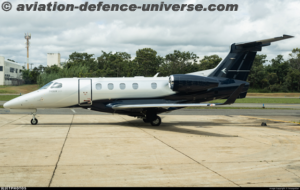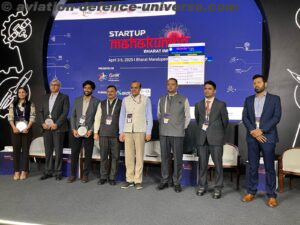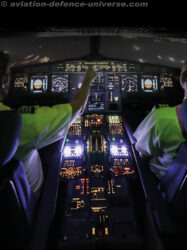By Deborah Circelli
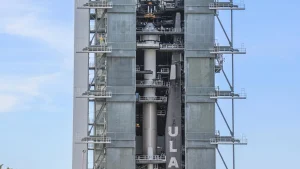 Cape Canaveral, USA. 17 April 2024. Starliner teammates cheered as the headlights of the transporter slowly neared the corner of the Commercial Crew and Cargo Processing Facility, soon revealing the Crew Flight Test spacecraft they’ve worked so hard on.
Cape Canaveral, USA. 17 April 2024. Starliner teammates cheered as the headlights of the transporter slowly neared the corner of the Commercial Crew and Cargo Processing Facility, soon revealing the Crew Flight Test spacecraft they’ve worked so hard on.
Knowing NASA astronauts Butch Wilmore and Suni Williams, who were also watching with them, will be flying on board for Starliner’s first crewed flight makes the milestone even more special for the team.
The Starliner rolled out from the back of the factory on a transport vehicle and left the parking lot at about 5 a.m. Eastern time. It made a slow, carefully orchestrated 10-mile (16-kilometer) trek to United Launch Alliance’s Vertical Integration Facility (VIF) at Cape Canaveral Space Force Station.
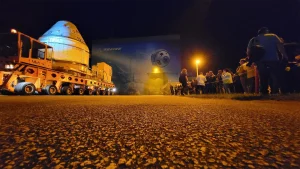
The spacecraft was later hoisted and integrated on top of ULA’s Atlas V rocket. Work will continue in the VIF before the May 6 launch to ensure the Atlas V and spacecraft are properly communicating with each other prior to launch.
The milestone has special meaning for launch campaign managers Richard Skinner and Amanda Ireland.
For Skinner, the rollout signifies nearing the end of a long career in human spaceflight, starting with working shuttle payloads in 1980 for McDonnell Douglas. He has also worked for ULA and the Space Launch System and was brought on to help Starliner with the orbital flight tests and then through the first crewed flight.
“Having a chance to get to meet and personally know our flight crew members, it will mean that much more when we see them leave for the pad,” said Skinner, who is also the convoy coordinator overseeing the transport operation of crew to ULA’s launch complex.
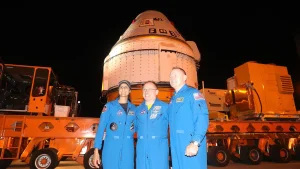
Ireland, who is also lead of launch operations and sits on console as the spacecraft liaison officer during launch, has been on the Starliner program for five years.
“Doing this work has been my dream job for a long time and it continues to be,” Ireland said. “So seeing us launch astronauts means everything.”
The two coordinated the rollout along with teams from Boeing and ULA, as well as Boeing and NASA security, and the U.S. Space Force.
A lot is involved before rollout, including making sure various antennas and GPS systems are working correctly in communicating information back and forth from the rocket to the Boeing Mission Control Center.
Now that the spacecraft is mated to the Atlas V, that work continues. Teams will go through a series of functional testing to make sure everything is connected correctly and communicating properly with the spacecraft and rocket.
Functionally this rollout was similar in nature to previous rollouts, Ireland said, including “treating the spacecraft with the greatest care and detail.” Ireland said the importance of having a successful Crew Flight Test is essential in ensuring multiple providers are able to reach different low Earth orbit locations in the future while advancing human spaceflight.
Another teammate, Mackenzie Palafox, worked with Skinner and Ireland on the rollout. Palafox has been with Starliner a little over a year, primarily as a manufacturing engineer, and agreed to take on the additional responsibilities to assist the launch campaign managers.
“I am so proud to be a part of this company’s legacy in human spaceflight,” Palafox said. “It’s really amazing to see it all coming together.”
Other members of the Starliner team were also on hand to watch the spacecraft leave the factory.
They cheered and snapped photos as the spacecraft made its way from around the Commercial Crew and Cargo Processing Facility.
Carol Wingrove, an electrical technician, who has been on the Starliner program for nine years, was thrilled to see the Starliner astronauts watching the rollout and all the support they’ve provided the team.
“I’m excited for everyone. We’ve waited so long,” Wingrove said. “We have astronauts on board. We made it. It took a lot of hard work from everybody, but it’s worth it to get to this point.”
Max Plavcan, Starliner Crew & Cargo Accommodations systems engineer, attended his first rollout. He started on Starliner as an intern in 2017 and was hired full time in 2020.
“It all feels surreal,” Plavcan said.
Rob Hughes, Starliner manufacturing engineer for four years, said he’s looking forward to sending crew to the space station and welcoming them home.
“This is why we all do this,” Hughes said. “It makes all the hard work we’ve done really pay off.”






































